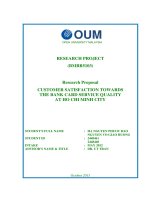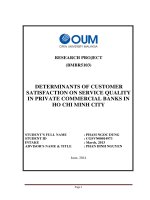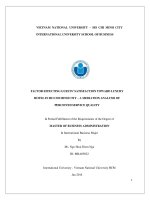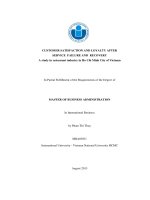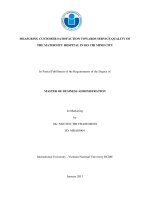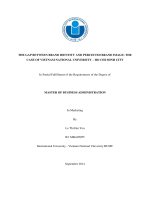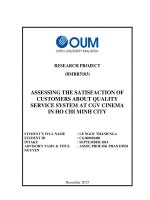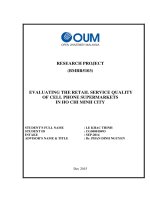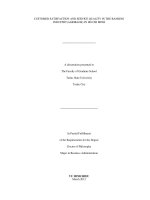The influence of service value and service quality in higher education on student satisfaction in industrial university ho chi minh city
Bạn đang xem bản rút gọn của tài liệu. Xem và tải ngay bản đầy đủ của tài liệu tại đây (6.97 MB, 92 trang )
UNIVERSITY OF ECONOMICS HO CHI MINH CITY
International School of Business
---------------------------
Le Duc Tho
The Influence of Service Value and Service Quality
in Higher Education on Student Satisfaction
in Industrial University Ho Chi Minh City
MASTER OF BUSINESS
Ho Chi Minh city – Year 2014
UNIVERSITY OF ECONOMICS HO CHI MINH CITY
International School of Business
---------------------------
Le Duc Tho
The Influence of Service Value and Service Quality
in Higher Education on Student Satisfaction
in Industrial University Ho Chi Minh City
ID: 22021172
MASTER OF BUSINESS
SUPERVISOR: ASSOCIATE PROFESSOR NGUYEN HAU LE
Ho Chi Minh city – Year 2014
Table of contents
List of acronyms ................................................................................................... I
List of figure ........................................................................................................ II
List of table .......................................................................................................... III
Chapter 1 Introduction
1.1. Higher education in Vietnam ......................................................................... 2
1.2. Research objectives ....................................................................................... 3
1.3. Scope of the research ...................................................................................... 4
1.4. Significance of the research ........................................................................... 4
1.5. Organization of the thesis .............................................................................. 5
Chapter 2 Literature review
2.1. Literature review ............................................................................................ 6
2.1.1. The concept of student satisfaction ............................................................. 6
2.1.2. Factors influencing student satisfaction toward the perceived
education service value and education service quality ............................... 7
2.1.2.1. Service Value ........................................................................................... 7
2.1.2.2. Service quality ......................................................................................... 8
2.2. Research model & hypotheses ....................................................................... 11
Chapter 3 Research method
3.1. Research procedure ........................................................................................ 12
3.2. Measurement of variables .............................................................................. 14
3.2.1. Education service value scale ..................................................................... 15
3.2.2. Education service quality scale .................................................................... 15
3.2.3. Student satisfaction scale ............................................................................ 15
3.4. Sampling Method ........................................................................................... 17
3.5. Data Analysis ................................................................................................. 18
Chapter 4 Research results
4.1. Data statistical analysis .................................................................................. 19
4.2. Scale Analysis ................................................................................................ 20
4.2.1. Exploratory Factor Analysis (EFA) of education service value ................. 21
4.2.2. Exploratory Factor Analysis (EFA) of education service quality .............. 22
4.2.3. Exploratory Factor Analysis (EFA) of student satisfaction ........................ 25
4.5. Confirmatory Factor Analysis (CFA) result ................................................... 25
4.6. Research hypotheses test ............................................................................... 26
4.6.1. Theoretical model test by using SEM approach ......................................... 26
4.7. Regression Analysis ....................................................................................... 29
4.8. Results of Multi-group analysis ..................................................................... 31
4.8.1. Testing the moderating effects of gender variable
(Male and female) ....................................................................................... 32
4.8.2. Testing the moderating effects of major favourite level
(Like and Dislike) ....................................................................................... 35
Chapter 5 Discussion, Implication and Limitations
5.1. The main results ............................................................................................. 40
5.1.1. Result contributions to theory ..................................................................... 40
5.1.2. Result contributions to management practices ........................................... 41
5.2. Limitations of the study and directions for further research …………...……45
LIST OF ACRONYMS
-
UIH: University of Industry Ho Chi Minh city
-
HCM: Ho Chi Minh
-
EFA: Exploratory Factor Analysis
-
CFA: Confirmatory Factor Analysis
I
LIST OF FIGURE
Figure 2.1 - The research model of factors influence on satisfaction.
Figure 3.1 – Research procedure.
Figure 4.1 - CFA for suggestion model.
Figure 4.2 - CFA for adjusted model.
Figure 4.3 - AMOS results in both variance and partial invariance models of genders.
Figure 4.4 - AMOS results in both variance and partial invariance models of major
favourite level.
II
LIST OF TABLE
Table 2.1 - Comparing topics in student satisfaction surveys.
Table 3.1 – Measurement scales
Table 4.1 - A descriptive statistics of the sample
Table 4.2 - Illustrated the EFA result for Education Service Value
Table 4.3 - Illustrated the EFA result for Education Service Quality
Table 4.4 - Illustrated the EFA result for Student Satisfaction
Table 4.5 - The relations among concepts in suggestion model and adjusted model
Table 4.6 - Regression analysis result of service value
Table 4.7 - Regression analysis result of service quality
III
ABSTRACT
This study empirically examines the effects of Perceived Education Service Value and
Education Service Quality on University Student Satisfaction. This article examines the
concept of service value in business edu- cation with data collected from 495 students. The
research also explores the moderating role of University Type variable on these relationships.
The results indicate that both University Service Quality and Education Service Value play
significant role in predicting Student Satisfaction. Through previous researches, perceived
value of services is recognized as a major form of assessment of customer service, this study
helps to understand the exact structure of the value and quality of undergraduate training in
economics and business. The study identified factors affecting the perception of value and
service quality, and satisfaction. Since then, researchers have a suggestion for shaping the
strategy to add value to students and make them more satisfaction in the learning process. The
results of model studies have important implications for the management of education in
Vietnam in the formulation of policies to enhance service value and quality of service. These
policies include not only the dissemination of information to form emotional values, values
satisfy the desire degrees, functional value (price / quality) but also covers aspects of
management to improve service quality, enhance the school's image and elevate the value of
prior knowledge of the students feel about the university.
The research findings also engage with some limitations in the strength of measurement scale,
the sampling method as well as the fitness between the research model and data. It results in the
valuable directions for further researches in future.
Key words
Student satisfaction, Service, Value, Quality
1 | Page
Chapter 1
INTRODUCTION
1.1. Higher education in Vietnam
There is the fact that Viet Nam has 412 universities and colleges so the higher education in
Vietnam has been existing as a strong competitive market (www.giaoduc.net.vn). The standard
of universities still is not homogeneous and the general fee of high education in Vietnam is not
cheap compared to the income of many people, so the choice of learners is difficult and
considerable when they decide to engage in the university which supply good condition for
them to study. Moreover, the competition between public universities and private universities
in attracting students requires universities should meet the needs of the learners better. Thus,
satisfaction of students will contribute to build the image of the business school in the
community, enhance the ability to attract good students into their university and thereby
contribute to the results of school education. In addition, numerous researchers have focused
their attention on measuring levels of customer satisfaction (Churchill and Surprenant, 1982;
Myers, 1991), and on identifying the dimensions used by customers in their evaluation of
service quality (Carman, 1990; Gronroos, 1990) and service quality (Harvey, 1995; Hill, 1995).
So, factors affecting student satisfaction, there are two major elements: "Education service
quality" and "education service value" that the universities offer students.
Many people agree that universities, with the guideline take learner to be core value, should
consider students as service customers who need to be concerned and cared (Hoanh, 2003). For
the students, many students have considered education services as a commodity, in the sense
that they should be concerned and served. For those students (customers), they have the right to
2 | Page
choose for themselves a university supplying good service quality and providing value of
services to their own perception.
Currently, many educational managers regard university education as a kind of service and they
also understand the importance of education services to attract good students to their university
(Mazzarol, Geoffrey Normal Soutar, 2001). There have been many opinions, seminars and
workshops to discuss the quality of education on the part of work management and teaching.
However, a official study to find out "education service quality" and especially for "education
service value" from the perspective of students, the customers of educational services, has not
been paid attention yet. Therefore, the university should identify a reliable measurement of the
value of education services and education service quality to see the direction to improve and
perfect services, meet the increasing education needs of learners. However, there has not a
official study to measure effects of education service value and education service quality to the
levels of student satisfaction in Vietnam.
1.2. Research objectives
Student satisfaction will contribute to enhance the university's reputation and the ability to
attract good students. Moreover, it improve the general student standard of input in order to
improve to the quality of the students’ output. Thus, which important factors will impact on
student satisfaction, and how they affects on student satisfaction is what this study discover.
Basing on these issues above, the purpose of this research aims to develop and demonstrate the
effects of two factors (1) the value of education services perceived by students’ experiences,
and (2) the quality of education services create the level of student satisfaction with education
services at the same time. In detail, the objectives of this research are to determine:
1. To identify the relevant components of service quality and service value in the case of
university education service in University of Industry in Vietnam
2. To investigate the impact of service quality on customer satisfaction (direct and indirect via
service value).
3 | Page
1.3. Scope of the research
The empirical setting in this particular research is the business higher education in the context
of Industrial University Ho Chi Minh City, Vietnam. The study employs the determinants of
higher education service quality through the perceived service value – perceived service quality
- to explain the impacts on customer satisfaction toward the tertiary education. The last point
needs to be mentioned is that the subject of study and observation is the under-graduate fulltime students only.
1.4. Significance of the research
The research make the theory clearly and apply to practice in education managements, faculties
and students. As following:
• The research results can help people working in education management in University of
Industry the overview of the structure of the service value and service quality perceived
by students as a basis to help set the direction and policy development education
services at the university. The Board of Management and Faculties, relevant functional
departments of the University of Industry can use this result to construct development
plans, improve operations management and education better.
• This study raise the importance and the significance of voice students in higher
education innovation for people working in education management.
• Results of this study also helps students in Industrial University feel themselves a clearer
sense of the values that students can benefit.
• Faculty and undergraduate students and graduate students can use this project as an
example of teaching and learning subjects of scientific research methods.
• Lecturer specialized use statistical findings as teaching situations of treatment methods
of data analysis for undergraduate students and graduate students.
• Results of the study is a good reference for the Board of Management of the other
universities in the study of similar problems.
4 | Page
1.5. Organization of the thesis
This research is constructed in five parts. The first is the introduction of the study. The second
is the literatures review and hypotheses. Following is the research method. The next part is the
results. The conclusion comprises the final section of this research.
• Chapter 1 – Introduction: The overview of the research project.
• Chapter 2 - Literatures review and hypotheses:
Presents the theoretical basis of the
value of education services, service quality, student satisfaction and building a research
model with hypotheses.
• Chapter 3 - Research method: Presents the results of testing and analysis scales
describe the study sample.
• Chapter 4 – Research results: Analyzing the research model and the differences
between the groups of students to the perceived service value and service quality.
• Chapter 5 – Discussions, Implications and Limitations: Summarizing the main
results of the study, the significance of research for educational managers, and
limitations of the study and directions for further research.
5 | Page
Chapter 2
LITERATURE REVIEW AND HYPOTHESES
2.1. Literature review
2.1.1. The concept of student satisfaction
According to Besterfield (1994), Barsky (1995) and Kanji and Moura (2002), customer
satisfaction is a complex construct as it has been approached differently. As expressed by
Levesque and McDougall (1996), satisfaction is conceptualized as an overall, customer attitude
towards a service provider. Also customer satisfaction has been described as an affective
response, focused on product performance compared to some prepurchase standard during or
after consumption (Halstead et al., 1994). In contrast, Mano and Oliver (1993) establish that
satisfaction is an attitude or evaluative judgement varying along the hedonic continuum
focused on the product, which is evaluated after consumption.
Giese and Cote (2000) through his study concluded that satisfaction comprises three main
elements including:
• Affective response which varies in intensity.
• Satisfaction focus around product choice, purchase and consumption.
• Time of determination which varies by situation, but is generally limited in duration.
The above theories allow to develop the specific definitions which are suitable to each context
of each study. Therefore, to meet the objectives of this research, student satisfaction is defined
as following:
• The expectations of students entering the Industrial University compares to what the
students have been supplying when they learn at this university.
• Standardization of an university compares to university where students are learning.
6 | Page
• Satisfaction based on knowledge from experience by evaluating teaching service and
learning supports provided by the university.
2.1.2. Factors influencing student satisfaction toward the perceived education service
value and education service quality
2.1.2.1. Service Value
In many previous studies, many researchers have described customers' evaluation of value as a
function of the monetary and nonmonetary costs, such as the sacrifices associated with utilizing
the product/service and the benefits or utility received in tradeoffs (Doyle, 1984; Hauser and
Urban,1986).
To interpret an existing concept, Zeithaml (1988 ) presents four definitions of customer
perceived value, which is : “value is low price, value is want satisfaction, value is the quality I
get for the price I pay, and value is what I get for what I give''. Thus, we can understand that the
tradeoffs between costs and benefits and arises from both quality and price. Value can be
conceptualized as the overall evaluation of the service consumption experience (Holbrook,
1986, 1994); and, like quality and satisfaction, value can be encounter specific or a more
enduring global evaluation (Rust and Oliver, 1994).
LeBlanc and Nguyen (1999) and serial studies of Sheth et al. (1991) have examined perceived
service value is through the study of college student, the authors have identified 5 fundamental
value of education services included: Functional value, social value, emotional value, epistemic
value, and condition value.
Functional value is related to economic utility, the benefits associated with possessing the
product/service (the economic person theory), and underlies the performance of the object on a
series of salient attributes such as price, reliability and durability.
Social value concerns the utility derived from the customers' association with certain social
groups. The notice of friends and customers' association with members of reference groups
(Park and Lessig, 1977) are deemed to play an important role in the consumer evaluation of
product/services.
7 | Page
Emotional value, for its part, is described as the ability of a product/service to arouse feelings
or affective states and is measured on an ensemble of feelings toward the object.
Epistemic value is defined by Sheth et al. (1991) as the ability of a product/service to provide
novelty and/or satisfy a desire for knowledge. Epistemic value is considered to be a key
function of value and can influence behavioural inten- tions and switching behaviour (Zeithaml
et al., 1996).
Conditional value is described as the set of situations that the customer faces when making a
choice. In this context, situational variables are deemed to have an impact upon the customer's
assessment of the utility of the product/service. For example, the size of a business school and
the parents' views with regard to its programs are situational vari- ables which have the
potential to influence the value of the educational experience.
Above theories of 5 service values was tested by statistics in study of LeBlanc and Nguyen
(1999). This theory is used as a research foundation for exploring the perceived value in the
context of education services at the Industrial University Ho Chi Minh City.
Insight on how customers evaluate their value during actual use of the service is still a
controversial issue in the academic major. Indeed, understanding value from the customers'
perspective can provide useful information to management for allocating resources and
designing programs that promise to satisfy students better (Seymour, 1992) and for adapting
the business school's environment to the needs of students (Hampton, 1993). As a result, this
should elicit positive emotional responses from students with regard to their business school
and generate positive word of mouth (Fitzgerald Bone, 1995). Thus, the larger value of the
services provided by university is, the more satisfied students study in that university. The first
hypothesis is proposed as following:
H1: There is positive relationship between service value and student satisfaction.
2.1.2.2. Service quality
The definition of quality may vary from person to person and from situation to situation. The
most important contributions from academic theory about the quality of services including the
8 | Page
concept of perceived quality, satisfaction, expectations and perceptions. Defining quality is
conceptualized in the theory is perceived service quality. Perceived Quality comes from the
general evaluation of the customer service experience. The differences between quality and
satisfaction is that quality is the general attitude, while satisfaction refers to a specific
transaction. There is a relationship between two concepts of quality and satisfaction.
The satisfaction through a series of transactions will lead to the good perception of quality
(Aldridge and Rowley, 1998). According to Gronroos (1988) and Parasuraman et al. (1988),
the notion that quality evaluations as perceived by customers stem from a comparison of what
the customers feel that the organisation should offer (that is, their expectation) and their
perceptions of the performance of the organisation providing the service.
Further developments in educational research , Hill (1995) and Harvey (1995) made the list of
sub - quality training services in a university used to investigate student perceptions of quality
of services provided by the school. Table 2.1 shows typical student satisfaction topics as cited
by Harvey (1995), and compares these with a similar list described by Hill (1995). A
comparison of the two lists demonstrates that whilst there are similarities, there are also
differences, which are, to some extent, determined by the facilities offered by the specific
organisation. It is also important to note the function-specific focus of these questions which
enhances the potential for managerial relevance (Rust et al., 1995).
9 | Page
Table 2.1 - Comparing topics in student satisfaction surveys.
Harvey’s topics
Hill’s topics
Library services
Computer services
Refectories
Accommodation
Course organisation and assessment
Teaching staff and teaching style
Teaching methods
Student workload and assessment
Social life
Self – development
Financial circumstance
University environment
Library service
Computing facilities
Catering service
Accommodation service
Course content
Personal contact with academic staff
Teaching quality
Student involvement
Work experience
Financial services
Feedback
Joint consulation
University bookshop
Career service
Counselling welfare
Health service
Student’s union
Physical education
Travel agency
The application of this theoretical basis, the survey sub - quality services in accordance with
the current state of the facilities of the Industrial University has been developed and presented
in the questionnaire.
More recently, the marketing managers tried to understand clearly the dynamics of the
relationship that exists between satisfaction and service quality and their impact on customers'
purchase intentions. The purpose of service quality improvement is to attract and to maintain
customers. Quality always has a relationship with satisfaction because customer satisfaction
will lead to repurchase intention and that helps organizations have profit (Galloway, 1996). In
the university environment, the students believe that the more quality of services provided by
the university, the higher satisfied they are at that university. In addition, it has also been found
that customers' assessments of service value are positively related to their assessments of
service quality (Bolton et al., 1991). Thus, it could be expected that service value underlie the
10 | Page
service quality.
This leads to the second and the third hypothesises is proposed as following:
H2 : There is positive relationship between service quality and student satisfaction.
H3 : There is positive relationship between service quality and service value.
2.2. Research model & hypotheses
From above three hypotheses, a research model is proposed, shown in Figure 1.
• Research model
Figure 2.1 - The research model of factors influence on satisfaction.
H3 (+)
Service Quality
Service Value
H2 (+)
H1 (+)
Satisfaction
• Hypotheses
H1: There is positive relationship between service value and student satisfaction.
H2: There is positive relationship between service quality and student satisfaction.
H3: There is positive relationship between service quality and service value.
11 | Page
Chapter 3
RESEARCH METHOD
3.1. Research procedure
This study will be implemented through the combination of qualitative research and
quantitative research, which procedure is presented in Figure 3.1.
12 | Page
Figure 3.1 – Research procedure
13 | Page
3.2. Measurement of variables
Scale in this study based on the theory of service value, service quality perceived by the
students, and the level of student satisfaction. A set of observed variables (the speech) was built
to measure the latent variables (study concept). Due to the differences between culture and
economic infrastructure, so the scale can be designed in developed countries is not appropriate
for Vietnam market. Through expert consultation and preliminary study with sample size n =
12, the observed variables have been modified to suit the thinking and copywriting style of the
objects of study. The purpose of the preliminary survey is to make clear the items from
measurement scale based on the standpoint of customers. Moreover, preliminary survey helps
writer to find out the mistakes and where interviewees did not understand. Hence, the necessary
modification can be carried out in order to increase the power of scale. In addition, this step
also provides the opportunities to gain new idea, new items to enhance the research model and
measurement scale. The participants of the survey were the undergraduate student in University
of Industry HCM city. They were chosen from different majors to ensure the generalization of
the opinions. It was consistent of the purpose of the research is to explore the standpoint of
primary customer of higher education service, that is student. Moreover, participants were
chosen from third year and last year students to make sure that they have experiences in
performance of higher education service. Official survey were conducted when the
questionnaire was revised from the results of preliminary survey.
The specific variables are measured on a five-point-Likert scale, ranging from 1 = Strongly
disagree, 2 = Disagree, 3 = Neutral, 4 = Agree, 5 = Strongly Agree. Latent variables are
measured by the interval scale, starting 1 = low/ not satisfied to 5 = high/ completely satisfied.
Almost main ideas of these question are based critically on the question sources, but, there is
still something the author will adjust to be suitable for Vietnam context and the purpose of this
research.
14 | Page
3.2.1. Education service value scale
Education service value represents what students have compared to what students have to
spend to study at university. Education service value scale measured by adapting LeBlanc and
Nguyen (1999) and modified through qualitative research with 30 items. The scale of the
concept has 30 observed variables, including 29 variables assessed service value related to the
various aspects of the services provided by the Industrial University as the function service
value, university fees, university image, the perceived value of a degree, emotional value and
social value, and 1 variable assess the value of overall education services (See Table 3.1).
3.2.2. Education service quality scale
Education service quality scale measured by adapting Hill (1995) and Harvey (1995) and
modified through qualitative research with 21 items. Service quality is measured in the overall
assessment of students' experience of using services provided by the school. This scale consists
of 20 observed variables assessing the quality of different services such as education content,
teaching methods, exam, student assessment, teaching and learning facilities, library service,
health service, careers service, financial service, personal contact with academic staff and
feedback from university leaders. In addition, there is one observed variable used to assess the
overall quality of the education services. (See Table 3.1)
3.2.3. Student satisfaction scale
Student satisfaction scale measured by adapting Giese and Cote (2000) and modified through
qualitative research with 3 items. The study includes 3 observed variables evaluates the student
satisfaction which students are obtained in the course of study at the Industrial University. (See
Table 3.1)
15 | Page
Table 3.1 – Measurement scales
Education service value scale
F1
Functional value (Want satisfaction)
SV1
A degree in IUH will allow me to earn a good salary.
SV2
The knowledge I have acquired at my universityl will allow me to get promotions.
SV3
I believe that employers need students graduated from my university
SV4
Degree I have from IUH is the good investment for my future
SV5
A degree from my IUH will guarantee future employment.
F2
Epistemic value
SV6
The quality of education received from my professors influences the value of my degree.
SV7
Course contents influence the value ofmy education.
SV8
The guidance received from professors has an effect on the value of my education.
SV9
The number of students in my classes influences the value of my education.
SV10
Education environment influences the value of my education I received
F3
Image value
SV11
I learn new things in many of my courses.
SV12
I learn positive things about my university.
SV13
The reputation of my university influences the value of my degree.
SV14
The university image in community projected influence on the value of my degree.
SV15
I believe that IUH can adapt to the needs of industry.
SV16
I believe that employers have positive things about my university
SV17
IUH is a large university and it has an effect on the value of my education.
F4
Emotional value
SV18
I find courses interesting.
SV19
Courses are suitable to my favourite
SV20
I am happy when I have a right choice.
SV21
The value of my education depends on my personal effort.
F5
Functional value (quality compared to tuition fee)
SV22
My parents believe that my university offers good programs.
When considering the price I pay for tuition, I believe that my university offers sufficient
SV23
services.
When considering the price I pay for tuition, I believe that the price/quality ratio is good at
SV24
my university.
SV25
I believe that my university offers quality services.
F6
Social value
SV26
I am happy when friends are in my classes.
SV27
I find courses more interesting when friends are in my classes.
SV28
Working in groups has a positive effect on the value of my education.
SV29
Social activities at my university make my studies more interesting.
16 | Page
SV30
The general assessment of student about the value of overall education services
Education service quality scale
F1
Education activities
SQ1
University training programs that are suitable to the requirements of practice.
SQ2
The course content is updated, innovated, good to meet training requirements.
SQ3
Methods of teaching faculty is suitable to the requirements of each course.
SQ4
Lecturer with deep knowledge about the subject undertaken.
SQ5
The evaluation and grading of student are fair.
SQ6
Organisation of examinations, the examination supervisor are seriously.
F2
University facilities
SQ7
Class size (number of students in a class) is suitable to acquire subjects.
School facilities (lecture halls, furniture, audiovisual media...) meet the needs of training
SQ8
and learning.
SQ9
Computer room meets the real needs of students.
SQ10
Library facilities good (quantity and quality of books, and seating space).
SQ11
Library staff serves good (style, attitude of employees, service hours).
F3
Support service
SQ12
Canteen serves needs of books and learning materials for students.
SQ13
Medical services, health care response to student needs.
Academic advising activities, career counseling meet the needs of searching, selection and
SQ14
learning of students.
SQ15
Financial service supports enought student needs.
SQ16
Social activities, movement activities at the IUH strongly.
SQ17
Beverages Catering Service (Canteen) is suitable to the needs of students.
SQ18
Dormitory Service meet demand of students.
SQ19
Secretary Staff, ministry, inspection serve students enthusiastic when needed.
SQ20
University and departments regularly listen to and collect student opinions.
SQ21
The general assessment of student about the quality of overall education services
Student Satisfaction
SS1
Studying at IUH better than what I expected
SS2
University of Industry like my perfect university which I hope
SS3
I satisfy when I study at IUH
3.4. Sampling Method
Design targeted sample is an important steep in finding correct answers to research questions
(Sekaran and Bougie, 2011, p.262). After conducting qualitative research, the survey via
questionnaire is completed. This study includes 52 variables, in which 49 variables are
17 | Page
independent and 03 dependent variables. According to Hair, Black, Babin, and Anderson
(2010), a general rule, the sample size should be 100 or greater and the minimum sample
should have a desired ratio of 5 observations per variable. n > 100 samples and n = 5k (where k
= the number of variables). Therefore, the minimum sample size is n = 5x52 = 260. For
standard multiple regression analysis, Tabachnick and Fidell (1991) proposed that the desired
level is:
n > 50 + 8m (where m = number of independent variables). Hence, the required sample is:
n > 50 + 8x52 = 466 .Thus, the minimum sample size is 466.
Samples were selected by quota sampling method combined with two convenient criteria:
major and student years. Preliminary study with email survey held with a total of 30 students,
along with discussions on the value of business education held with students in a services
marketing class provided the basis for developing the questionnaire used in this study. For the
email survey, participants from both sexes were selected. During these interviews, participants
were questioned on various aspects concerning the services and facilities offered by Industrial
University, and on how they evaluated the value of their education. After testing the survey, the
questionnaire was modified and prepared for the official survey.
3.5. Data Analysis
Following previous steeps in collecting data activities, all the available data will be entered into
the SPSS and AMOS software program. Prior analyzing data, the author make sure that there is
no mistake occurring in accessing data. Besides, the distribution of data from the sample will
also be checked to satisfy the measurement tools.
18 | Page

